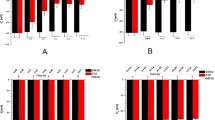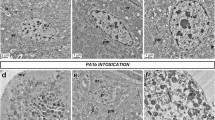Abstract
Cotton bollworm, Helicoverpa armigera, is one of the most damaging polyphagous pests worldwide, which has developed high levels of resistance to commonly applied insecticides. Mitochondrial P-glycoprotein (Pgp) was detected in the insecticide-resistant strain of H. armigera using C219 antibodies, and its possible role was demonstrated in the efflux of xenobiotic compounds using spectrofluorometer. The TMR accumulated in mitochondria in the absence of ATP, and effluxed out in presence of ATP; the process of efflux was inhibited in the presence of ortho-vandate, an inhibitor of Pgp, in insecticide-resistant larvae of H. armigera. The mitochondria isolated from insecticide-resistant larvae were resistant to insecticide-induced inhibition of oxygen consumption and cytochrome c release. Membrane potential decreased in a dose-dependent manner in the presence of higher concentration of insecticides (>50 µM) in mitochondria of insecticide-resistant larvae. In conclusion, mitochondrial Pgp ATPase detected in the insecticide-resistant larvae influenced the efflux of xenobiotic compounds. Pgp might be involved in protecting the mitochondrial DNA and the components of the electron transport chain from damage due to insecticides, and contributing to the resistance to the deleterious effects of insecticides on the growth of insecticide-resistant H. armigera larvae.








Similar content being viewed by others
Abbreviations
- FCCP:
-
Carbonyl cyanide p-(trifluoromethoxy) phenylhydrazone
- MDR:
-
Multidrug resistance
- Pgp:
-
P-glycoprotein
- TMR:
-
Tetramethylrosamine
References
Sharma, H. C. (2005). Heliothis/Helicoverpa management: Emerging trends and strategies for future research. New Delhi: Oxford and IBH Publishing Co.
Kranthi, K. R., Jadhav, D. R., Wanjari, R. R., Kranthi, S., & Russell, D. (2001). Pyrethroid resistance and mechanisms in field strains of Helicoverpa armigera Hubner (Lepidoptera: Noctuidae). Journal of Economic Entomology, 94, 253–263.
Srinivas, R., Udikeri, S. S., Jayalakshmi, S. K., & Sreeramulu, K. (2004). Identification of factors responsible for insecticide resistance in Helicoverpa armigera. Comparative Biochemistry and Physiology Part C: Toxicology & Pharmacology, 137, 261–269.
Lanning, C. L., Fine, R. L., Sachs, C. W., Rao, U. S., Corcoran, J. J., & Abou-Donia, M. B. (1996). Chlorpyrifos oxon interacts with the mammalian multidrug resistance protein, P-glycoprotein. Journal of Toxicology and Environment Health, 47, 395–407.
Leslie, E. M., Deeley, R. G., & Cole, S. P. C. (2005). Multidrug resistance proteins: Role of P glycoprotein, MRP1, MRP2, and BCRP (ABCG2) in tissue defense. Toxicology and Applied Pharmacology, 204, 216–237.
Gottesman, M. M. (2002). Mechanisms of cancer drug resistance. Annual Review of Medicine, 53, 615–627.
Prasad, R., Murthy, S. K., Prasad, R., Gupta, V., & Lata, S. (1996). Multidrug resistance: An emerging threat. Current Science, 71, 205–213.
Murray, C. L., Quaglia, M., Arnason, J. T., & Morris, C. E. (1994). A putative nicotine pump at the metabolic blood–brain barrier of the tobacco hornworm. Journal of Neurobiology, 25, 23–34.
Bain, L. J., & LeBlanc, G. A. (1996). Interaction of structurally diverse pesticides with the human MDR1 gene product P-glycoprotein. Toxicology and Applied Pharmacology, 141, 288–298.
Baldini, N., Scotlandi, K., Serra, M., Shikita, T., Zini, N., Ognibene, A., et al. (1995). Nuclear immunolocalization of P-glycoprotein in multidrug-resistant cell lines showing similar mechanisms of doxorubicin distribution. European Journal of Cell Biology, 68, 226–239.
Molinari, A., Cianfriglia, M., Meschini, S., Calcabrini, A., & Arancia, G. (1994). P-glycoprotein expression in the Golgi apparatus of multidrug resistant cells. International Journal of Cancer, 9, 789–795.
Munteanu, E., Verdier, M., Grandjean-Forestier, F., Stenger, G., Jayat-Vignoles, C., Huet, S., et al. (2006). Mitochondrial localization and activity of P-glycoprotein in doxorubicin-resistant K562 cells. Biochemical Pharmacology, 71, 1162–1174.
Solazzo, M., Fantappiè, O., Lasagna, N., Sassoli, C., Nosi, D., & Mazzanti, R. (2006). P-gp localization in mitochondria and its functional characterization in multiple drug-resistant cell lines. Experimental Cell Research, 312, 4070–4078.
Pullikuth, A. K., & Gill, S. S. (1997). Primary structure of an invertebrate dihydrolipoamide dehydrogenase with phylogenetic relationship to vertebrate and bacterial disulfide oxidoreductases. Gene, 200, 163–172.
Kaur, P., Radotra, B., Minz, R. W., & Gill, K. D. (2007). Impaired mitochondrial energy metabolism and neuronal apoptotic cell death after chronic dichlorvos (OP) exposure in rat brain. Neurotoxicology, 28(6), 1208–1219.
Armes, N. J., Jadhav, D. R., Bond, G. S., & King, A. B. S. (1992). Insecticide resistance in Helicoverpa armigera in South India. Pesticide Science, 34, 355–364.
Chamberlin, M. E. (2004). Control of oxidative phosphorylation during insect metamorphosis. American Journal of Physiology: Regulatory, Integrative and Comparative Physiology, 287, 314–321.
Akbar, S. Md, Sharma, H. C., Jayalakshmi, S. K., & Sreeramulu, K. (2012). Interaction of plant cell signaling molecules, salicylic acid and jasmonic acid, with the mitochondria of Helicoverpa armigera. Journal of Bioenergetics and Biomembranes, 44, 233–241.
Lowry, O. H., Rosenbrough, N. J., Farr, A. L., & Randal, A. J. (1951). Protein measurements with the folin phenol reagent. Journal of Biological Chemistry, 193, 265–275.
Borgnia, M. J., Eytan, G. D., & Assaraf, Y. G. (1996). Competition of hydrophobic peptides, cytotoxic drugs, and chemosensitizers on a common P-glycoprotein pharmacophore as revealed by its ATPase activity. Journal of Biological Chemistry, 271, 3163–3171.
Laemmli, U. K. (1970). Cleavage of structural proteins during the assembly of the head of bacteriophage T4. Nature (London), 227, 680–685.
Gerard, C. (1990). Purification of glycoproteins. Methods in Enzymology, 182, 529–539.
Aurade, R. M., Jayalakshmi, S. K., & Sreeramulu, K. (2010). P-glycoprotein ATPase from the resistant pest, Helicoverpa armigera: Purification, characterization and effect of various insecticides on its transport function. Biochimica et Biophysica Acta, 1798, 1135–1143.
Kim, M., Cooper, D. D., Hayes, S. F., & Spangrude, G. J. (1998). Rhodamine-123 staining in hematopoietic stem cells of young mice indicates mitochondrial activation rather than dye efflux. Blood, 91, 4106–4117.
Braguini, W. L., Cadena, S. M. S. C., Carnieri, E. G. S., Rocha, M. E. M., & de Oliveira, M. B. M. (2004). Effect of deltamethrin on functions of rat liver mitochondria and on native and synthetic model membranes. Toxicology Letters, 152, 191–202.
Joshi, D. C., & Bakowska, J. C. (2011). Determination of mitochondrial membrane potential and reactive oxygen species in live rat cortical neurons. Journal of Visualized Experiments,. doi:10.3791/2704.
Sreeramulu, K., Liu, R., & Sharom, F. J. (2007). Interaction of insecticides with mammalian P-glycoprotein and their effect on its transport function. Biochimica et Biophysica Acta, 68, 1750–1757.
Lu, P., Liu, R., & Sharom, F. J. (2001). Drug transport by reconstituted P-glycoprotein in proteoliposomes-effect of substrates and modulators, and dependence on bilayer phase state. European Journal of Biochemistry, 268, 1687–1697.
Ling, X., He, Y., Zhang, G., Zhou, Y., & Yan, B. (2012). Increased P-glycoprotein expression in mitochondria is related to acquired multidrug resistance in human hepatoma cells depleted of mitochondrial DNA. International Journal of Oncology, 40(1), 109–118.
Bonnet, S., Archer, S. L., Allalunis-Turner, J., Haromy, A., Beaulieu, C., Thompson, R., et al. (2007). A mitochondria-k+ channel axis is suppressed in cancer and its normalization promotes apoptosis and inhibits cancer growth. Cancer Cell, 11, 37–51.
Acknowledgments
This work was supported in part by UGC to S Md Akbar (under RFSMS scheme), UGC—SAP (DSR—I), New Delhi to KS and the Ministry of Agriculture, Government of India to HCS. We are indebted to Dr FJ Sharom, Professor, Department of Molecular and Cellular Biology, University of Guelph, Canada, for reading the manuscript before its submission and her helpful discussions in improving the manuscript.
Author information
Authors and Affiliations
Corresponding author
Rights and permissions
About this article
Cite this article
Akbar, S.M., Aurade, R.M., Sharma, H.C. et al. Mitochondrial P-Glycoprotein ATPase Contributes to Insecticide Resistance in the Cotton Bollworm, Helicoverpa armigera (Noctuidae: Lepidoptera). Cell Biochem Biophys 70, 651–660 (2014). https://doi.org/10.1007/s12013-014-9969-5
Published:
Issue Date:
DOI: https://doi.org/10.1007/s12013-014-9969-5




